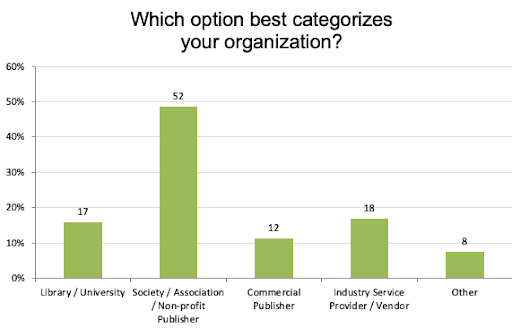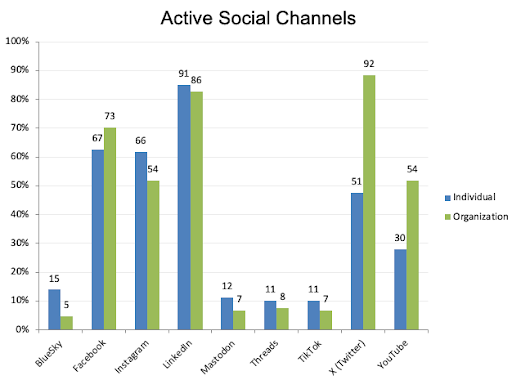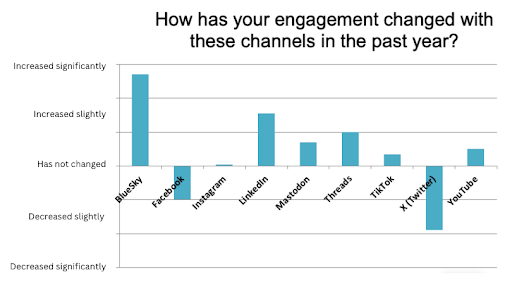Editor’s Note: Today’s post is by Stephanie Lovegrove Hansen, Anne Stone, Jennifer Regala, Susan Willner, and Jackie Lord. Stephanie is is the Vice President of Marketing at Silverchair. Anne is owner of Stone Strategic Marketing Services serving the associations, publishers and organizations in the research ecosystem. Jennifer is the Director of Publications/Executive Editor at the American Urological Association. Susan is the Associate Director, Publications for the American Society of Nephrology. Jackie is the Marketing and Operations Manager for the Society for Scholarly Publishing.
The Society for Scholarly Publishing’s (SSP’s) Marketing and Communications team (along with marketers everywhere) is working hard to find a central online gathering spot where we can all share live event coverage, ruminate about industry developments, and communicate our shared passion for scholarly publishing. Where X/Twitter once largely filled our need for virtual networking and information sharing between the SSP Annual Meeting, New Directions, and regional SSP events, we have heard from many in our community about your desire to find an agreed-upon hangout spot for our global crew to convene.
Anecdotal stories and eyewitness accounts of the great migration from the once-glorious Twitter weren’t enough to know that we need to find a new social media platform home. Enter the SSP Social Media Survey launched in November, which generated 106 responses from individuals across the scholarly publishing ecosphere. The survey was announced in an Ask the Community post on The Scholarly Kitchen and, of course, promoted across social media throughout the month. About half of the respondents were individuals associated with a society/association or other non-profit publisher. Industry service providers, librarians, university professionals, and commercial publishers rounded out the rest.
What are the differences between individual use of social media channels and organizational use?
Respondents were asked to identify the social media platforms where they were individually as well as organizationally active. More respondents reported being individually active on LinkedIn (85%) than X/Twitter (47%), reflecting many anecdotes shared in our initial Ask the Community post.
The top three social media platforms selected for individuals were LinkedIn (85%), Facebook (63%), and Instagram (62%). When asked on which channels their organization was active, X/Twitter moved to the top position (88%), followed by LinkedIn (83%) and Facebook (70%).
Although only 27% of the respondents indicated they individually use YouTube, 52% said their organization uses it. Some of us love YouTube for hockey videos of the Washington Capitals Stanley Cup run, Barbie movie key scenes, and classic rock videos. At the same time, recorded webinars on professional topics are posted to YouTube for the nerdier among this author team. The strong response from societies to the survey may explain the difference in YouTube usage from an organizational perspective, since many societies use that channel to promote content like interviews with society leadership, highlights from events, and member spotlights.
This pattern of low individual use but high organizational use was also seen for X/Twitter. Supporting and detracting sentiments include:
“We conducted an audit of our social channels across the portfolio back in August, which confirmed that Twitter is still where we find the most engagement. It also remains the largest driver of social traffic back to journal content. While I would love to dictate that researchers use another platform, social media strategy is rooted in meeting your community members where they are gathering… My personal preference would be for LinkedIn to come out ahead, as the mix of professional-to-professional and public engagement makes it close enough to Twitter but with a higher degree of civility. But we must go where our communities go!”
“There is still a lot of value placed on spaces such as X within our academic community, and so despite the ethical and moral objections I may have to it, we still use it, and I still need an account to keep up to date from time to time.”
“For our scientific society, Twitter’s greatest value was the ability to keep a finger on the pulse of our community, track important and emerging issues, and get to know scientists who might not actively engage with us in other ways. While our members always used multiple platforms, Twitter was by far the one with the greatest engagement because it allowed scientists to engage both with each other and the public in one place. There is still plenty of activity there, but not like it once was.”
We saw an inverse result for BlueSky activity. 14% of respondents reported being individually active on BlueSky, while <5% said their organization was active there.
How is social media engagement changing?
When asked how engagement with these channels has changed in the past year, the overall trend shows the most increase in usage of BlueSky and LinkedIn, with Threads and Mastodon also increasing noticeably. The growth of BlueSky engagement isn’t surprising, as we saw individuals and organizations clamor for those invites.
Meanwhile, usage of X/Twitter experienced the most dramatic decrease in usage, with Facebook also decreasing slightly. Future surveys might look to tease apart the differences between individual and organizational changes on LinkedIn and X/Twitter. Who is following whom?
The most common theme in open-text responses was dissatisfaction with the direction of X/Twitter and the resultant challenges for scholarly publishers, coupled with a reluctance about lingering on the platform.
“We feel uncomfortable with the direction of X and would prefer alternatives to communicate and collaborate with our scholarly networks.”
“We were putting a lot of effort (mostly pointless) into growing our journal’s Twitter following. Have essentially dropped this — it no longer is a place that reflects our Journals’ values — high standards, truth, civility.”
“The automated X feed on our websites no longer shows any content unless you are logged in to X, making it a waste of page real estate for many website users.”
“Twitter was once a fairly open platform, but that openness is gone.”
“The scholarly publishing community seemed alive and active on Twitter for many years, but over the past year, there has been such a drastic decline in useful and interesting exchanges, I now completely forget to even go to Twitter.”
“Our organization continues to go through the motions posting on X/Twitter hoping to regain some traction, especially with event hashtags, but engagement continues to plummet without paying for a verified organizational account.”
What is the future of social media engagement with the research community and scholarly publishing?
Respondents pointed out that not all social media channels were represented. We learned of Spoutible, born in 2023, and of course 1.3 billion people use WeChat. More targeted community platforms include ResearchGate, with 25 million registered members. Here’s what we heard from respondents:
“I’m curious to see how many people mention Discord, as this has been the largest jump in my own use within the professional realm. Library workers ask questions, post tips, and resources, and welcome open discussion about library-related topics (and our pets, of course), and the groups are large enough and often focused enough to be extremely useful for those willing to engage.”
“We’ve seen increased engagement on LinkedIn and Instagram. Early this year, it seemed Mastodon was where a lot of our members were going to most directly replace the niche Twitter filled, but now it seems Bluesky is the leader among these new platforms. (Threads, not so much.)”
“I have tried Mastodon, but it is quite confusing and so fragmented that I spend too much time navigating, plus it doesn’t have the breadth of users to make it worthwhile. LinkedIn has become my social media of choice for work, but it does not provide the same kind of casual engagement, and it’s not the place for compelling discussions and heated debates. Live tweeting an event would not go over well on LinkedIn, and the idea that your LinkedIn comments do not represent those of your employer seems false since your employer is generally at the top of your profile!”
“I am not sure that scholarly publishing has a viable community option in social media at this time 🙁 I have my eyes open, but nothing is ‘it’ as of right now IMO.”
“All of this has made social media harder for our organization to manage given the same set of time, personnel, and resources, and we definitely view its value with a bit of a more skeptical eye than in the past while we look to other communications channels to serve us more reliably.”
After reading all this, perhaps this respondent’s sentiment resonates with you:
“I feel fatigued by it all. Just want info about our projects and events to reach people in the simplest way.”
Ultimately, the SSP MarComm committee is rooted in SSP’s core values of community, adaptability, integrity, and inclusivity. As such, our fundamental goal is to unite the SSP community while extending an open invitation to those seeking a scholarly publishing home. In a global, digital world, we believe we can find an online platform to support these core values and our need to vibe with one another.
SSP’s c3 Community Forum is one such place. While the SSP Member Exchange is a space for SSP members to share ideas, ask questions, and network with peers, communities like Industry Announcements and Events and Scholarly Publishing DEIA Resources are open to anyone in the community. Marketers who want to continue this conversation about the explosion of channels and marketing for our industry may consider contributing to the thread“What’s the state of marketing in academic publishing?”
Social media can be what you make of it. With your help, we’ll find (or create!) a spot where all are welcome to share opinions, news, and all things scholarly publishing in those times between in-person meetings, nurturing the professional and social networks we need.

Discussion
5 Thoughts on "Guest Post — Scholarly Social: Findings from the SSP Social Media Survey"
I have a handful of Bluesky invitations if anyone is interested. Drop me a line at scholarlykitchen@sspnet.org
When David’s invitations run out, I can share some, too: JRegala@AUANet.org 🙂 Happy holidays!!!!
I have some Bluesky invites as well. Swillner@asn-online.org
I would love to see how this changes in 6 months. I’m on Threads, and the engagement there is increasing daily, especially now that it’s opened to Europe as well.
These are interesting and quite encouraging results, and pushed me to get to grips with my Bluesky account I have been idling over for too long. We will probably start an account for EASE on there too.
I think one of the factors that helped establish Twitter for academic publishing community was the Altmetric capturing of tweet activity. Measuring the activity was a bonus value to using it and surely did help direct more publisher, if not also individual activity towards it. Getting LinkedIn and other platform mentions incorporated into Altmetric (and PlumAnalytics) is long overdue – I know Amye and Graham mentioned this was in the works in the previous post. I think that which platforms Altmetric can work with will play a part in determining where activity goes in the longer term.
I do agree with that last quote highlighted; the disparate channels and loss of momentum in being able to converse is fatiguing.
So far this year I have really found LinkedIn to be the most receptive and effective for me, the journal I am working with and EASE. Between how I have been using Twitter, Mastodon, Facebook, IG, Threads and LinkedIn, LinkedIn has the most features and people to make it worth investing time and effort in for a variety of reasons, but it is a little more cumbersome and formal than Twitter. We still need somewhere that allows for being agile, spontaneous, professional and casual.
And to end on a little more of an emotive note, the decline of Twitter has been really sad and frustrating. I want to get everything off it as soon as possible. I am not sure what my threshold is, for closing everything on there, but it is lowering with each passing day.






